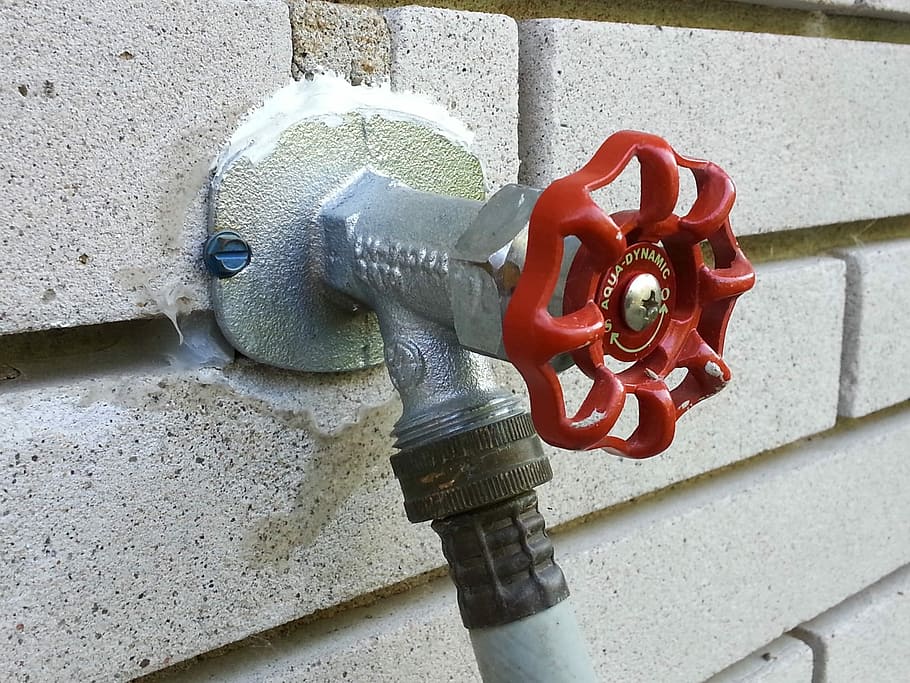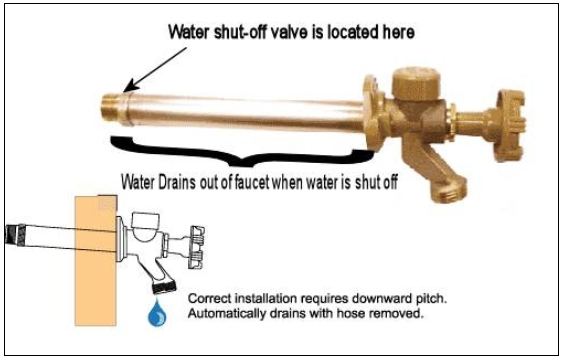There are a few times when the cold weather of winter gives up a few half-decent days that bring you outside to get a few chores done before retreating back to the warmth of your home. Using your hose for these chores can be a huge bonus and with a frost-free outdoor valve, you can have outside water available without the fear of bursting by freezing over. How does a frost-free faucet work?
When you shut off the water on a frost-free faucet, the H2O stops behind the valve, which is set further back inside the home where the interior air temperature is warmer, the H2O left in the outer portion of the pipe which is pitched downward drains to the outside leaving nothing left to freeze.
On the outside of your home, a frost-free faucet looks the same as a traditional faucet, but the inside parts are different they can make the difference between a burst pipe and a valve causing damage and keeping you from using it until spring.
How Can You Tell If an Outdoor Spigot is Frost Free
Frost-proof outdoor faucets are compression valve faucets that can operate in temperatures as low as 32 degrees Fahrenheit. Frost Proof Faucets are types of faucets that can offer dependability in colder climates.
A regular, frost-free outdoor faucet has a handle that turns a shorter type of shaft. As the handle turns clockwise a pad on the other end of the shaft plugs a hole, shutting off water flow. If you turn the handle counter-clockwise the pad moves away from the hole increasing water flow. Because the valves are installed low, near the ground, the short shaft is usually designed to sit at an angle to make it easier to turn for a person bending over.
When you shut off the water on a frost-free faucet, the water stops behind the valve, which is set further back inside the home. This means the water won’t freeze because it stays where the interior air temperature is warmer.
This downward pitch allows water to drain out when the faucet is shut off. When frost-free sillcocks aren’t installed with this downward pitch, water will sit inside the stem of the sillcock even when it’s turned off.
A frost-free faucet will also have a long stem called a Sillcock that turns off the water well inside the wall, keeping the faucet from freezing. The best and most durable sillcocks will be most commonly made from corrosion-resistant brass a very reliable metal for use in harsh conditions.
A sillcock is an outdoor water faucet that is located and attached to the exterior of a house. Sillcocks are nothing more than spigots that you’ll find coming out of your house. They essentially have a spout to which to connect hoses or just access tap water while outside. The sillcock allows you to use the water valve in colder months without the danger of the outside valve freezing.
A Sillcock unlike a hose bib which sometimes is confused with has a longer rod that extends into the wall of the house. The water valve for a sillcock is generally located at the end of this long rod where it connects to the piping within the wall.
Frost Free Outdoor Faucet Types
- Spigots & Hose Bibs: known as wall hydrants, spigots, sillcocks, etc. hose bibbs are the fixtures you commonly see on the outside of a home. They are threaded so that you can easily attach and secure a hose. They are typically made up of a single valve stem system but can have more than one.
- Wall Hydrants: a valve that provides the convenience of water outside your house while requiring little winterizing. Ideally used where freezing is possible, wall hydrants protect against damage. The shut-off normally occurs inside the house.
- Ball Valve & “Quarter-Turn” Faucets: A ball valve is a flow control device that opens/closes 1/4 turn that uses a hollow, perforated, and pivoting ball to control fluid flowing through it. It is open when the ball’s hole is in line with the flow inlet and closed when it is pivoted 90 degrees by the valve handle, blocking the flow.
- Freeze-Proof Faucets: includes a section of pipe often 8 inches or longer attached to the back of the faucet body. Inside the pipe is a rod with a washer at the rear indoor end that controls the flow of water into the pipe and ultimately out through the faucet spout.
Frost Free Hose Bib Installation
Proper installation means the frost-free faucet should be angled downward slightly to let the H2O run out of the valve and pipe. When replacing an old faucet, you first need to use a pipe wrench to remove the old spigot. Depending on the size of the new sillcock, you may need to make the hole bigger to accommodate a larger pipe. You can then insert the new sillcock with the downward angle positioning.
Many frost-proof faucets have vacuum breakers, also called anti-siphon devices. This device stops water from being sucked from your hose back into your water system, where unsanitary hose water can be mixed with your potable water contaminating it.
How Deep Should a French Drain Be
Check out this great article right here on MyWaterEarth&Sky-The last time I installed a French Drain it was around the perimeter of my inground pool whose, one side faced a steep uphill which brought a flood of puddling, ………. Continue reading
JimGalloway Author/Editor

Reference:
MyWaterEart&Sky-How to Protect Pool Equipment From Freezing

